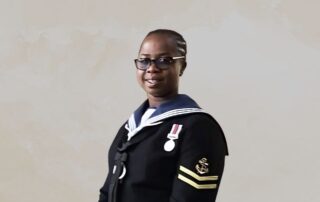“Senior Service”
The Royal Navy (RN) is the United Kingdom’s naval warfare force and a component of His Majesty’s Naval Service. Although warships were used by English and Scottish kings from the early medieval period, the first major maritime engagements were fought in the Hundred Years’ War against France. The modern Royal Navy traces its origins to the early 16th century; the oldest of the UK’s armed services, it is consequently known as the Senior Service.
From the middle decades of the 17th century, and through the 18th century, the Royal Navy vied with the Dutch Navy and later with the French Navy for maritime supremacy. From the mid-18th century until the Second World War, it was the world’s most powerful navy. The Royal Navy played a key part in establishing and defending the British Empire, and four Imperial fortress colonies and a string of imperial bases and coaling stations secured the Royal Navy’s ability to assert naval superiority globally. Owing to this historical prominence, it is common, even among non-Britons, to refer to it as “the Royal Navy” without qualification. Following World War I, it was significantly reduced in size, although at the onset of World War II it was still the world’s largest.
During the Cold War, the Royal Navy transformed into a primarily anti- submarine force, hunting for Soviet submarines and mostly active in the GIUK gap. Following the collapse of the Soviet Union, its focus has returned to expeditionary operations around the world and it remains one of the world’s foremost blue-water navies.
The Royal Navy maintains a fleet of technologically sophisticated ships, submarines, and aircraft, including 2 aircraft carriers, 2 amphibious transport docks, 4 ballistic missile submarines (which maintain the nuclear deterrent), 6 nuclear fleet submarines, 6 guided missile destroyers, 11 frigates, 9 mine- countermeasure vessels and 26 patrol vessels. As of April 2023, there are 70 operational commissioned ships (including submarines as well as one historic ship, HMS Victory) in the Royal Navy, plus 13 ships of the Royal Fleet Auxiliary (RFA). There are also five Merchant Navy ships available to the RFA under a private finance initiative, while the civilian Marine Services operate auxiliary vessels which further support the Royal Navy in various capacities. The RFA replenishes Royal Navy warships at sea, and augments the Royal Navy’s amphibious warfare capabilities through its three Bay-class landing ship vessels. It also works as a force multiplier for the Royal Navy, often doing patrols that frigates used to do.
The Royal Navy is part of His Majesty’s Naval Service, which also includes the Royal Marines and the Royal Fleet Auxiliary. The professional head of the Naval Service is the First Sea Lord who is an admiral and member of the Defence Council of the United Kingdom. The Defence Council delegates management of the Naval Service to the Admiralty Board, chaired by the Secretary of State for Defence. The Royal Navy operates from three bases in Britain where commissioned ships and submarines are based: Portsmouth, Clyde and Devonport, the last being the largest operational naval base in Western Europe, as well as two naval air stations, RNAS Yeovilton and RNAS Culdrose where maritime aircraft are based.
Role
As the seaborne branch of HM Armed Forces, the RN has various roles. As it stands today, the RN has stated its six major roles as detailed below in umbrella terms.
History
History of the Royal Navy (before 1707), History of the Royal Navy (after 1707), and Royal Scots Navy
The English Royal Navy was formally founded in 1546 by Henry VIII, though the Kingdom of England had possessed less-organised naval forces for centuries prior to this.
The Royal Scots Navy (or Old Scots Navy) had its origins in the Middle Ages until its merger with the English Royal Navy per the Acts of Union 1707.
World War I
During World War I, the Royal Navy’s strength was mostly deployed at home in the Grand Fleet, confronting the German High Seas Fleet across the North Sea. Several inconclusive clashes took place between them, chiefly the Battle of Jutland in 1916. The British fighting advantage proved insurmountable, leading the High Seas Fleet to abandon any attempt to challenge British dominance.. The Royal Navy under John Jellicoe also tried to avoid combat and remained in port at Scapa Flow for much of the war.
This was contrary to widespread prewar expectations that in the event of a Continental conflict Britain would primarily provide naval support to the Entente Powers while sending at most only a small ground army.
Nevertheless, the Royal Navy played an important role in securing the British Isles and the English Channel, notably ferrying the entire British Expeditionary
Force to the Western Front without the loss of a single life at the beginning of the war.
The Royal Navy nevertheless remained active in other theatres, most notably in the Mediterranean Sea, where they waged the Dardanelles and Gallipoli campaigns in 1914 and 1915. British cruisers hunted down German commerce raiders across the world’s oceans in 1914 and 1915, including the battles of Coronel, Falklands Islands, Cocos, and Rufiji Delta, among others.
Interwar period
At the end of World War I, the Royal Navy remained by far the world’s most powerful navy, larger than the U.S. Navy and French Navy combined, and over twice as large as the Imperial Japanese Navy and Royal Italian Navy combined. Its former primary competitor, the Imperial German Navy, was destroyed at the end of the war. In the inter-war period, the Royal Navy was stripped of much of its power. The Washington and London Naval Treaties imposed the scrapping of some capital ships and limitations on new construction.
The lack of an imperial fortress in the region of Asia, the Indian Ocean, and the Pacific Ocean was always to be a weakness throughout the 19th century as the former North American colonies that had become the United States of America had multiplied towards the Pacific Coast of North America, and the Russian Empire and Japanese Empire both had ports on the Pacific and had begun building large, modern fleets which went to war with each other in 1904. Britain reliance on Malta, via the Suez Canal, as the nearest Imperial fortress was improved, relying on amity and common interests that developed between Britain and the United States during and after World War I, by the completion of the Panama Canal in 1914, allowing the cruisers based in Bermuda to more easily and rapidly reach the eastern Pacific Ocean (after the war, the Royal Navy’s Bermuda-based North America and West Indies Station was consequently re-designated the America and West Indies station, including a South American division. The rising power and increasing belligerence of the Japanese Empire after World War I, however, resulted in the construction of the Singapore Naval Base, which was completed in 1938, less than four years before hostilities with Japan did commence during World War II.
In 1932, the Invergordon Mutiny took place in the Atlantic Fleet over the National Government’s proposed 25% pay cut, which was eventually reduced to 10%. International tensions increased in the mid-1930s and the re-armament of the Royal Navy was well under way by 1938. In addition to new construction, several existing old battleships, battlecruisers and heavy cruisers were reconstructed, and anti-aircraft weaponry reinforced, while new technologies, such as ASDIC, Huff-Duff and hydrophones, were developed.
World War II
At the start of World War II in 1939, the Royal Navy was still the largest in the world, with over 1,400 vessels. The Royal Navy provided critical cover during Operation Dynamo, the British evacuations from Dunkirk, and as the ultimate deterrent to a German invasion of Britain during the following four months. The Luftwaffe under Hermann Göring attempted to gain air supremacy over southern England in the Battle of Britain in order to neutralise the Home Fleet, but faced stiff resistance from the Royal Air Force. The Luftwaffe bombing offensive during the Kanalkampf phase of the battle targeted naval convoys and bases in order to lure large concentrations of RAF fighters into attrition warfare. At Taranto, Admiral Cunningham commanded a fleet that launched the first all-aircraft naval attack in history. The Royal Navy suffered heavy losses in the first two years of the war. Over 3,000 people were lost when the converted troopship Lancastria was sunk in June 1940, the greatest maritime disaster in Britain’s history. The Navy’s most critical struggle was the Battle of the Atlantic defending Britain’s vital North American commercial supply lines against U-boat attack. A traditional convoy system was instituted from the start of the war, but German submarine tactics, based on group attacks by “wolf-packs”, were much more effective than in the previous war, and the threat remained serious for well over three years.
Cold War
After World War II, the decline of the British Empire and the economic hardships in Britain forced the reduction in the size and capability of the Royal Navy. The United States Navy instead took on the role of global naval power. Governments since have faced increasing budgetary pressures, partly due to the increasing cost of weapons systems.
In 1981, Defence Secretary John Nott had advocated and initiated a series of cutbacks to the Navy. The Falklands War however proved a need for the Royal Navy to regain an expeditionary and littoral capability which, with its resources and structure at the time, would prove difficult. At the beginning of the 1980s, the Royal Navy was a force focused on blue-water anti-submarine warfare. Its purpose was to search for and destroy Soviet submarines in the North Atlantic, and to operate the nuclear deterrent submarine force. The navy received its first nuclear weapons with the introduction of the first of the Resolution-class submarines armed with the Polaris missile.
Post-Cold War
Following the conclusion of the collapse of the Soviet Union and the end of the Cold War in 1991, the Royal Navy began to experience a gradual decline in its fleet size in accordance with the changed strategic environment it operated in.
While new and more capable ships are continually brought into service, such as the Queen Elizabeth-class aircraft carriers, Astute-class submarines, and Type 45 destroyers, the total number of ships and submarines operated has continued to steadily reduce. This has caused considerable debate about the size of the Royal Navy. A 2013 report found that the Royal Navy was already too small, and that Britain would have to depend on her allies if her territories were attacked.
The financial costs attached to nuclear deterrence, including Trident missile upgrades and replacements, have become an increasingly significant issue for the navy.











